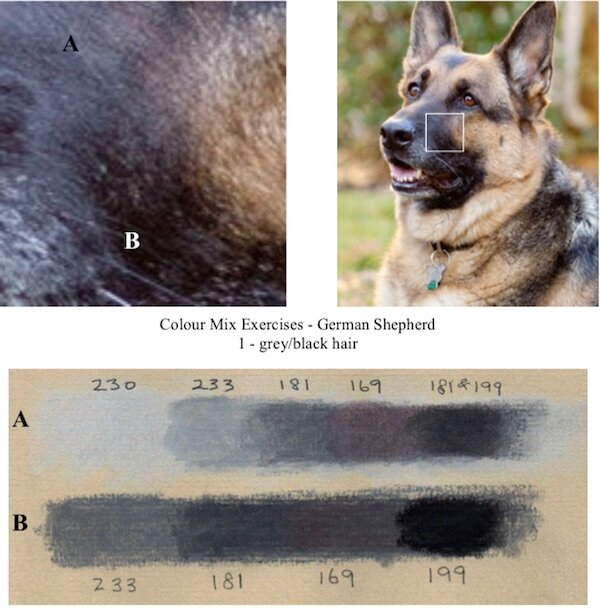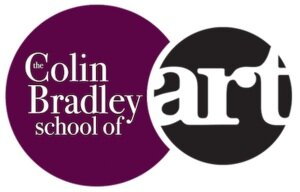Painting the Hair of a German Shepherd
The exercise below shows the pastel pencil colours needed to produce the grey/black hair of the German shepherd in the photograph. I have blown up the section I have used as an example from the photo to make it easier for you to located this area. These same colours would be used for all the other grey/black areas of hair on the animal including the nose. The two bands of colours above show the colours used to arrive at the final tone that is seen in the photograph. The colours referred to are from the Faber-Castell Pitt Pastel Pencil range. Line A shows first of all a base colour of 230 this is applied to the whole length of the band acting as a base colours for the other pencil numbers. 233 is applied on top of the 230 again along the whole length, then 181, 169 are applied in the same way. The final colour is a mix of both 181 again and also 199 which gives us the finishing tone. This means that this final dark tone has 230, 233, 181, 169, 181 again combined with 199 on top of each other.Line B shows first of all 233 applied along the whole length acting as the base colour then 181 on top of 233 right up to the end, then 169 in the same way. Finally the 199 black is placed at the end giving us the final tone. Compare the two finishing tones of A & B, this is the difference the 230 makes to the stronger colours when applying a lighter base.Note - there is a blue bias to the photograph that I have ignored but this could be added at the same stage as the 169 if desired. I have used cool colours in this exercise therefore did not feel the need to do this.Did you find this useful? Let us know in the comments below.
The two bands of colours above show the colours used to arrive at the final tone that is seen in the photograph. The colours referred to are from the Faber-Castell Pitt Pastel Pencil range. Line A shows first of all a base colour of 230 this is applied to the whole length of the band acting as a base colours for the other pencil numbers. 233 is applied on top of the 230 again along the whole length, then 181, 169 are applied in the same way. The final colour is a mix of both 181 again and also 199 which gives us the finishing tone. This means that this final dark tone has 230, 233, 181, 169, 181 again combined with 199 on top of each other.Line B shows first of all 233 applied along the whole length acting as the base colour then 181 on top of 233 right up to the end, then 169 in the same way. Finally the 199 black is placed at the end giving us the final tone. Compare the two finishing tones of A & B, this is the difference the 230 makes to the stronger colours when applying a lighter base.Note - there is a blue bias to the photograph that I have ignored but this could be added at the same stage as the 169 if desired. I have used cool colours in this exercise therefore did not feel the need to do this.Did you find this useful? Let us know in the comments below.

